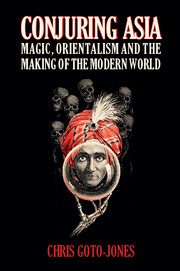4 - Indian magic and magic in India
from Part II
Published online by Cambridge University Press: 05 July 2016
Summary
Indian magic
Travellers have been reporting on the incredible magic of India for centuries. As we saw in the last chapter, these astonishing accounts built on and reinforced each other, gradually yet persistently establishing a popular representation of the subcontinent as a land of mystery, darkness, and wonder. Such accounts formed part of the cultural context of the Golden Age of Magic in the West, informing the public imagination of India and guiding the expectations of travellers who ventured in the footsteps of Marco Polo (1254–1324), Ibn Battuta (1304–1377), or the East Indian Company. Although China and then Japan also emerged as fantasies of enchanted lands during the Golden Age, it was India that remained firmly in the magical spotlight. When America's first specialist conjuring magazine was published in 1895, it was titled, Mahatma. While the first cover story was about Robert-Houdin, the ‘father of modern magic’, the image that swirled around the journal's title was of an India fakir or jādūwālā with a drum and a cane, charming a hooded cobra; a Western explorer sits partially obscured behind the banner he's holding (on which MAHATMA is written), gazing at the Indian magician.
Disgruntled by their own apparent marginality in this story, sceptical modern magicians of the turn of the twentieth century endeavoured to disenchant these romantic stories of Indian magic by appealing to the unreliability of pre-modern witnesses when compared with the scientific perspective of the modern eye. With characteristic confidence in the power of modernity, John Nevil Maskelyne declares that ‘as a rule the more modern the authority, the less improbability there is in the story; the less predominant is the element of romance, and the more nearly it approximates to the facts as we know them to be. We are, on the whole, keener observers nowadays, and we are more sceptical.’
As we saw in Chapter 3, however, Maskelyne and his confreres in magic were also deeply dubious about the ability of the average member of the modern public to see through Orientalism to the bare facts of what they witnessed. Indeed, Orientalism seemed to function as a kind of magic in itself, clouding the minds of travellers with mysterious mists through which even the simplest and most mundane of feats took on the proportions of fantastical wizardry.
- Type
- Chapter
- Information
- Conjuring AsiaMagic, Orientalism and the Making of the Modern World, pp. 155 - 204Publisher: Cambridge University PressPrint publication year: 2016



